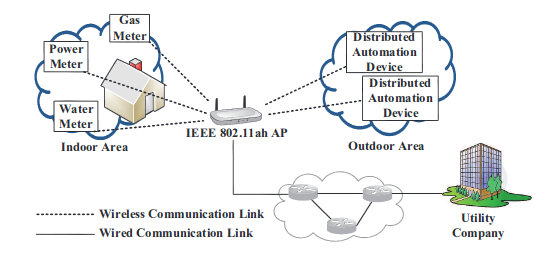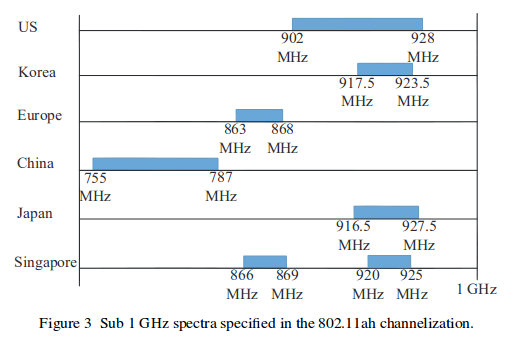Most devices now feature Wi-Fi modules capable of handling 802.11 b/g/n at 2.4 Ghz (and 5 GHz for dual band Wi-Fi), and newer devices and routers boast 802.11ac connectivity @ 5GHz with increased bandwidth (up to 1.2 Gbit/s in theory, maybe around 400 Mbit/s in practive), and in some case increased range with beam-forming. But thanks to an article on EETimes, I’ve learned there’s another upcoming Wi-Fi standard called 802.11ah operating in the 900MHz range, with data rates from 150 Kbit/s with a 1 MHz band to as much as 40 Mbit/s over an 8 MHz band, lower power consumption, and a least double of the range of a typical 802.11n device,capable of covering an area of about 1 km2. The target applications are sensors networks, backhaul networks for sensor and meter, and extended range Wi-Fi, as the standard allows long range and more clients at low bitrates.

This new Wi-Fi standard will compete with other sub 1GHz wireless standard such as Zigbee, and Z-Wave, and it seems to have similar applications as Wi-Fi 802.11af standard operating in the TV white band. Companies such as Broadcom, CSR, Huawei, Intel, LG, Marvell, NEC, Panasonic, Qualcomm, Samsung, and ZTE are participating in IEEE 802.11ah standard which is expected to get ratified by the end of 2015. If you want to learn more about technical details, you could read a publications entitled IEEE 802.11ah: A Long Range 802.11 WLAN at Sub 1 GHz by the Department of ECE and INMC from Seoul National University.
 A Greek company, Antcor, will demonstrate its 802.11ah DSP block supporting 4×4 MIMO for home gateways and industrial automation networks at Mobile World Congress 2014, and the first 802.11ah SoCs should hit the market before the end of this year, using the draft specifications.
A Greek company, Antcor, will demonstrate its 802.11ah DSP block supporting 4×4 MIMO for home gateways and industrial automation networks at Mobile World Congress 2014, and the first 802.11ah SoCs should hit the market before the end of this year, using the draft specifications.

Jean-Luc started CNX Software in 2010 as a part-time endeavor, before quitting his job as a software engineering manager, and starting to write daily news, and reviews full time later in 2011.
Support CNX Software! Donate via cryptocurrencies, become a Patron on Patreon, or purchase goods on Amazon or Aliexpress





Article about setting up the expensive Odroid* as a 802.11ac router in the Feb edition:
http://magazine.odroid.com/
*I guess because it’s the only one with USB3.0? Anyway 802.11ac adapters still seem very rare.
I don’t see 11ah gaining much traction since you need all of the different regional antennas at 900Mhz. Gains from using 900Mhz aren’t likely to offset the costs of the different antennas. Much easier way to get low power is to use existing wifi chips that have Bluetooth Low Energy already integrated.
I sure hope they DON’T get the standard, as it looks like they want to be able to use the entire frequency block for as little as 1 device. This band was NOT made for that. Max channel width should be limited to 1Mhz per device, and no multi-channel use!!!! This is for sensors, not porn!!! (I hate bandwidth hogs!!!)
Plus even with what they have proposed, it’s not going to be very low power friendly. :-/
Jon, as for antennas, the place I work at, handles every country world wide, and you just have to make everything based on the country you are selling to. This is one of the issues on almost every RF device, except maybe the 5Ghz stuff. Even the 2.4Ghz band is different world wide, though at the lower frequencies it gets much worse, antenna wise. But yes, antenna lengths are going longer than most people will want to use, and making a radio that can cover China and then the rest is pushing it a bit.
I think someone out there with lots of $$$ needs to push for a single ISM band standard worldwide, but then lock down usage cases (kind of like what DECT did). The lower frequency ones should stick with smaller band width devices, because of longer range, you’ll have more interference.